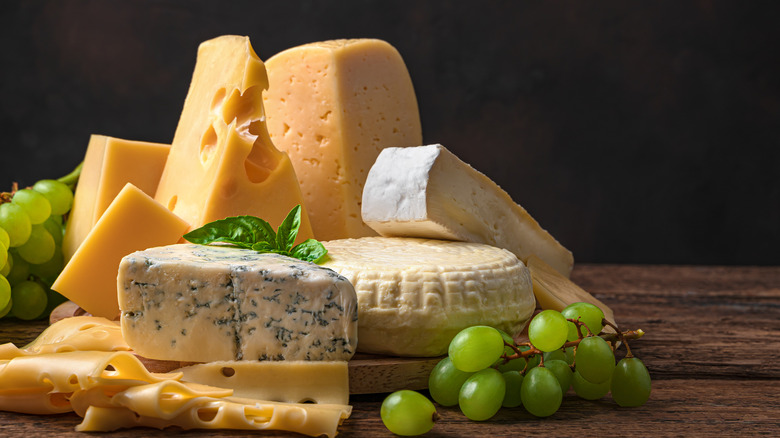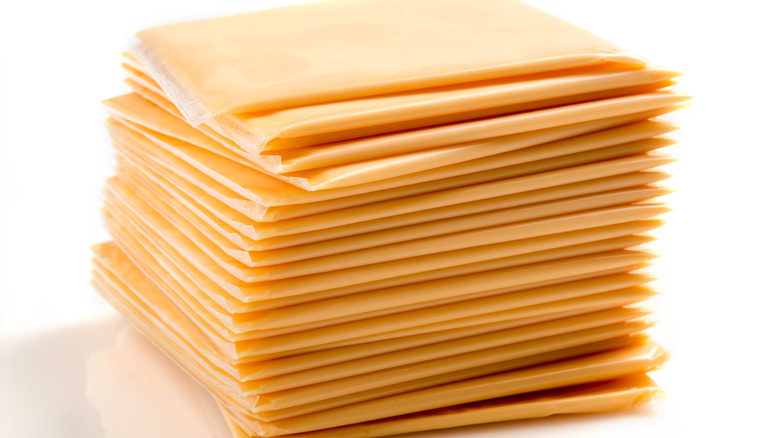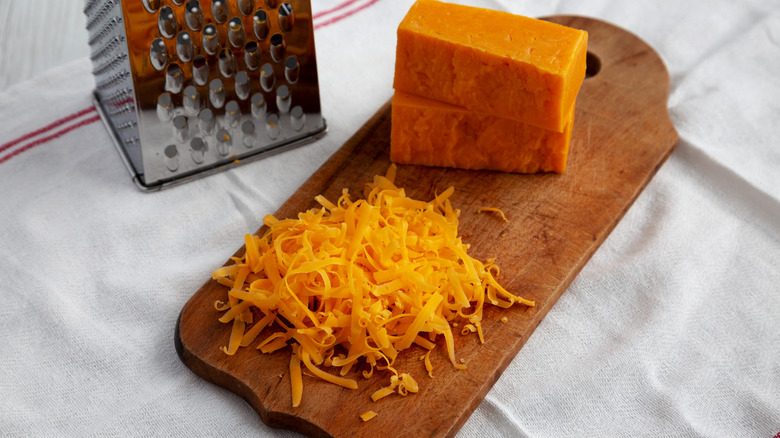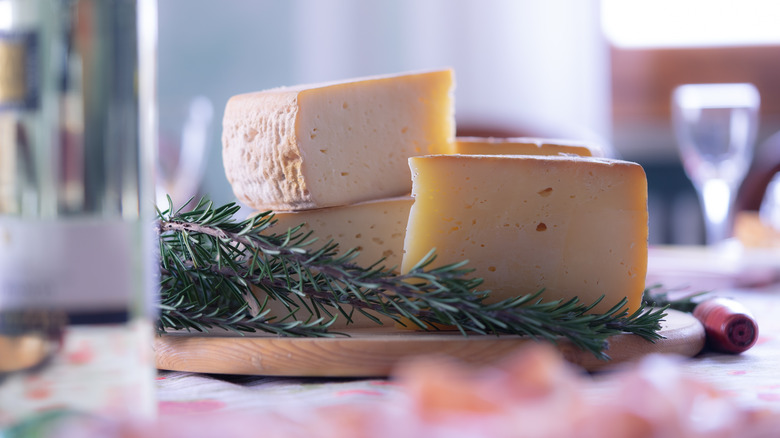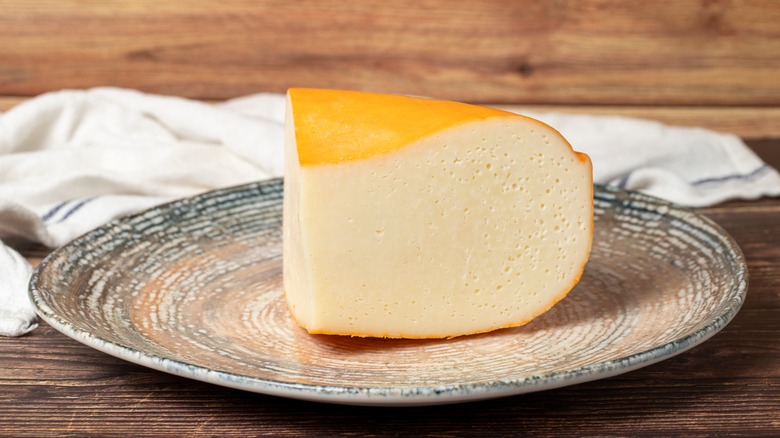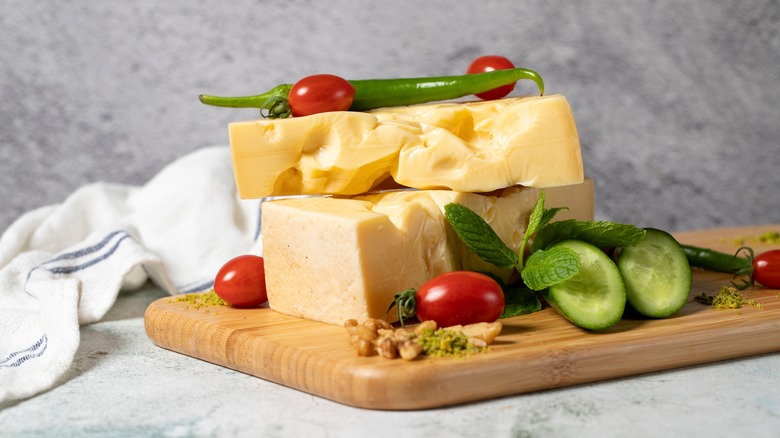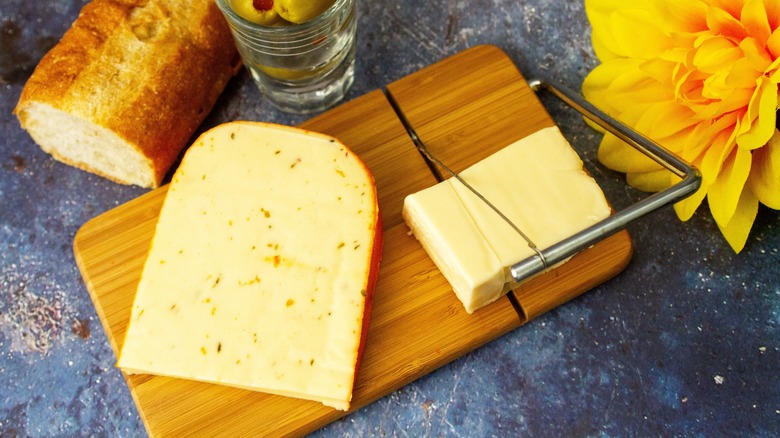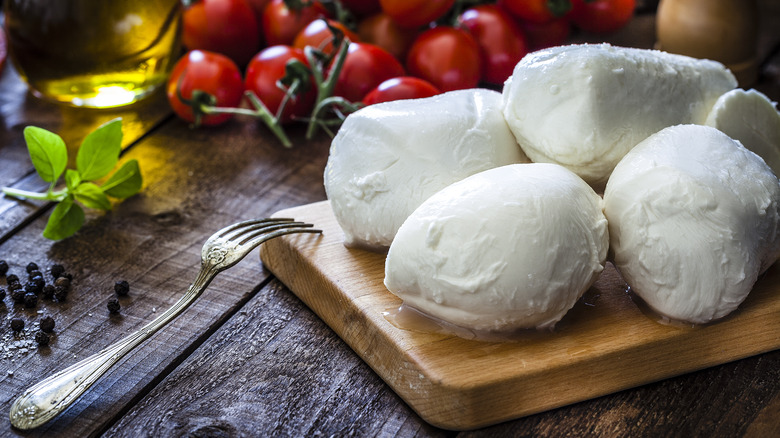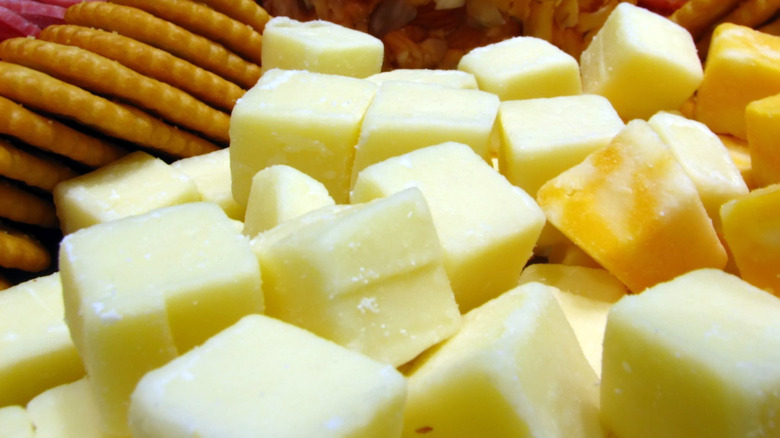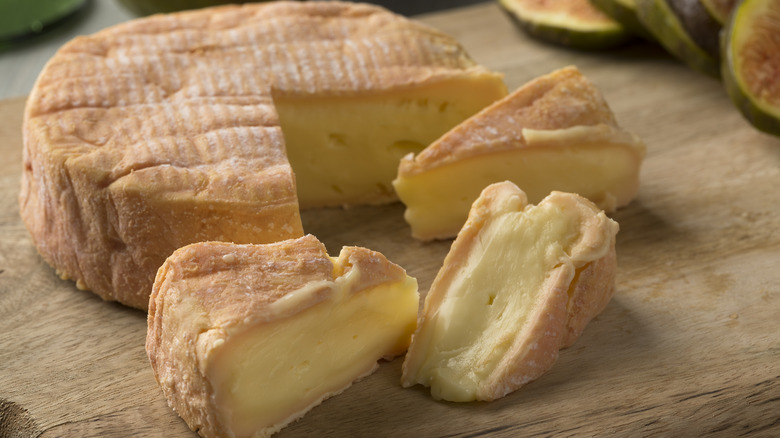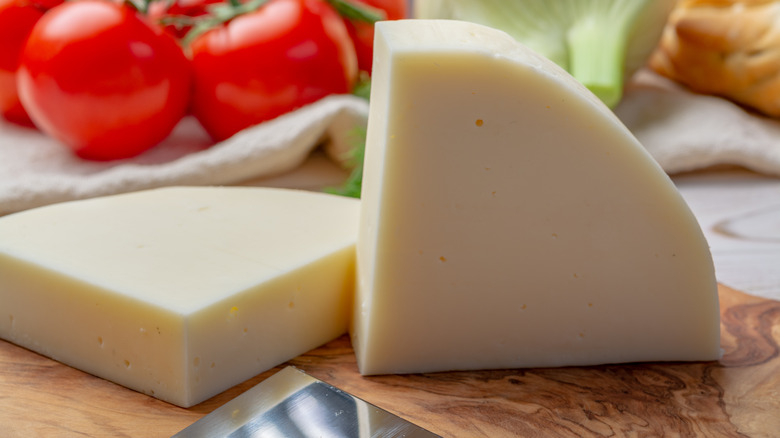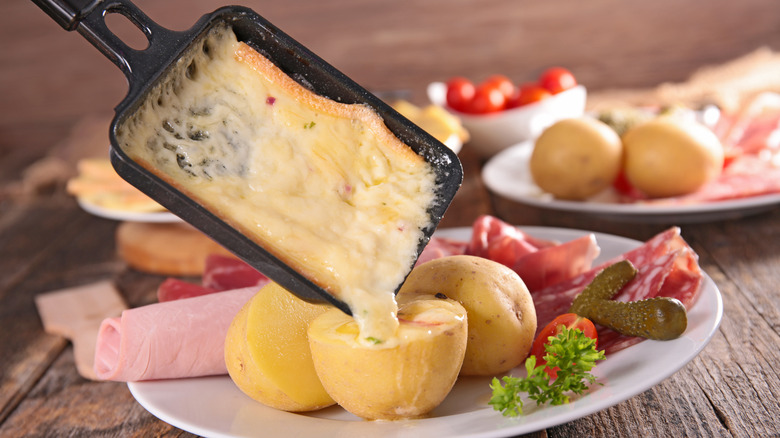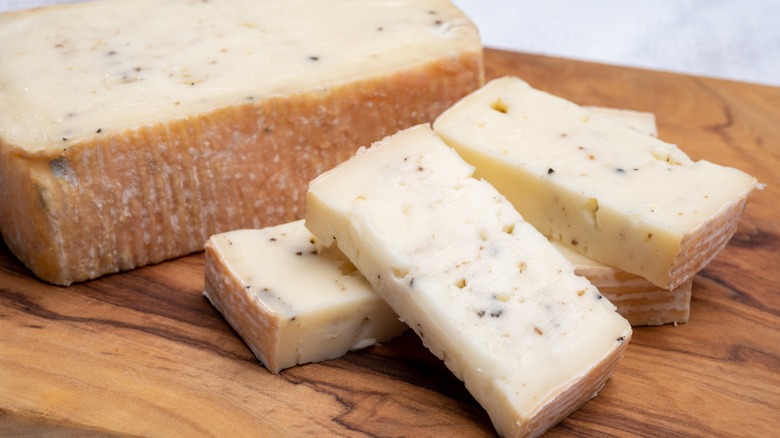Pros And Cons Of 12 Melting Cheeses
Cheddar, Parmesan, mozzarella, provolone ... few foods come in as many varieties as cheese does. Cheese can be soft, creamy, and spreadable, or it may be hard and in a block. It can be mild and sweet, sharp and tangy, or somewhere in between. Nearly any food can pair with some type of cheese, and it's a high-protein snack that can keep you going through your day.
One of the best things about cheese is how well it melts. Melty cheese is one of the best parts of grilled cheese sandwiches or pizza. It steals the show in macaroni and cheese as well as other pastas and casseroles. And of course, it's the main attraction in fondue.
There are many different cheeses, and not all are good for melting. Of those, some are better for certain things than others due to how they melt and what they actually taste like. Below, we've broken down some of the best-melting cheeses and explored their pros and cons.
1. American
American cheese, like those produced by Kraft or Velveeta, is a somewhat contentious cheese type. While it has a creamy texture and mild flavor, it doesn't technically qualify as cheese, and instead must be labeled a "cheese food." Originally, American cheese was made from a blend of cheddar and Colby cheese. It was created as a way to cut down on cheese waste by finding a way to utilize scraps from other batches of cheese.
If you're not typically a fan, you may want to reconsider your opinion on processed cheese. They melt easily to a smooth texture, unlike many other cheeses that get greasy, stringy, or separate when exposed to heat. This makes it a great option to cook with, as it will maintain its texture and blend with other ingredients.
However, some people just can't get over the fact that it's not "real" cheese. This is what's really in American cheese: milk, whey, milkfat, calcium phosphate (this is the same calcium found in milk), salt, sodium citrate (to keep the cheese creamy), sorbic acid (for preservation), cheese culture, enzymes, annatto extract (for color), and vitamin D3. Because cheese needs to be made with at least 51% real cheese, American gets relegated to "cheese food."
While that may seem like a long list of ingredients for cheese, they all work together to create a cheese that melts beautifully. This makes American cheese a great option for burgers, grilled cheese, tuna melts, and cheese sauces.
2. Cheddar
Cheddar is a type of cheese with many variations, from mild to sharp and from white to sunset orange. Here's what you need to know about cheddar cheese: Centuries ago, cheddar was accidentally created in Cheddar, England, after milk had been left in a cave that happened to be the perfect humidity and temperature. It's been a popular type of cheese ever since.
Because cheddar is so versatile, it can be used in many recipes and paired with many types of foods. It goes great with sweet items, like fruit, as well as with smokier flavors like paprika. It also pairs well with a range of meats from mild ham to spicy chorizo.
Unfortunately, its versatility also has a downside. When choosing cheddar, you need to be sure to choose the right type. Mild is great for snacking, but sharper is better for cooking. Additionally, some types are more likely to be laden with unnecessary ingredients. For example, cheddar gets that bright, glowy orange color because the color is added to it, not because it looks like that naturally.
Cheddar cheese, like American cheese, becomes creamy when melted, making both types better for burgers than many other cheeses. When buying cheddar for cooking, try to choose blocks over shredded cheese, as shredded cheese tends to have more preservatives and doesn't melt as well. Need some ideas? Check out these recipes to make with cheddar cheese.
3. Fontina
Fontina is a semi-hard cheese made from cow's milk that originated in northern Italy. It's incredibly flavorful, with notes of butter and roasted nuts. Though it can be pungent, it's also sweet, although the Italian version tends to be sharper than fontina made elsewhere. Most types are a pale yellow color with a smooth texture and may have some small holes similar to Swiss.
Thanks to its creamy, smooth texture, fontina typically melts beautifully. This makes it a great option to cook with, and it can be melted into sauces or pastas or used in pizzas or sandwiches. The unique flavor of this cheese also makes it a great choice for a cheese board or fondue. Another pro is that it typically is made without artificial preservatives or additives.
The downside to this delicious cheese is that you may not be able to find it at your typical grocery store, and it can often be more expensive than other types of cheese. The rind of fontina is usually not edible, as it's made of wax, so make sure everyone knows to avoid an embarrassing mistake. Another downside for some is the smell, which can be very strong.
Fontina should be stored in the fridge, but can also be frozen. It pairs well with sweet foods like chocolate and dark fruits like raisins and dates. The flavors tend to come out more when it's heated, so plan your recipes accordingly.
4. Gouda
Gouda is a versatile cheese that was first made in the Netherlands centuries ago. It's most often made from cow's milk and has a nutty, caramel flavor. The sweet flavor is partially due to the way gouda is made. All cheese is made from pressed curds, but the curds in gouda are rinsed first, which removes some of the lactic acid and gives the cheese a sweeter taste.
Gouda is great for melting and can be used in fondue, grilled cheese, pastas, and other dishes. Gouda also comes in many variations; young gouda is semi-hard and mild while aged gouda is harder with a more intense, tangy flavor. This allows you to choose how much flavor you want your cheese to have.
One con of gouda cheese is that it crystallizes. This happens when protein crystals break down in the cheese. While they're still safe to eat, the crystals can affect the texture, making it crunchy. The large variation in gouda can be a downside as well, as you may not know exactly what your cheese will taste like when you buy it.
Young gouda melts better than aged gouda and makes a great addition to macaroni and cheese and casseroles. Aged gouda doesn't need to be refrigerated if it will be out for a short time, but if you're looking to store it for a few weeks, it should be kept wrapped in the fridge.
5. Gruyère
Gruyère, like many types of cheese, was first made in Switzerland. It has a rich flavor that varies from fruity to nutty and is semi-hard and dense. It doesn't have holes like American Swiss cheese, but instead may have cracks throughout, especially as it ages and becomes flakier and more granular.
Gruyère is fantastic for melting, especially the younger, creamier varieties, thanks to its high milk fat content and high water-to-oil ratio. This makes it one of the best cheeses for fondue, but it's also great in French onion soup and makes the creamiest quiche.
Like gouda, the downside to Gruyère is that the flavor and texture can be very different depending on how old the cheese is. It can also be a little trickier to find than other types of cheeses, and the price point is often higher than other types of cheeses as well.
While Gruyère has a stronger flavor than American Swiss cheese, it's mild enough that it won't overwhelm other ingredients in your dish. It pairs well with smokey or salty foods but will complement a number of dishes.
6. Havarti
Of all the cheeses on this list, havarti is the only one to come from Denmark. This semi-soft cheese is made from cow's milk and has a smooth and creamy texture and a buttery, subtle taste. It has holes, like Swiss cheese, but the holes in havarti are smaller and more evenly distributed throughout the cheese. Most havarti ages for a few months, but some are aged up to a year, which gives the cheese a saltier and nuttier taste and firmer texture.
Havarti tends to be a crowd-pleaser, striking a good balance between mild and sharp. Because of its creamy texture and high moisture content, it melts smoothly and evenly. It's a great option for grilled cheese, pizza, casseroles, quesadillas, and fondue.
There are very few cons to havarti. Those who prefer a stronger-tasting cheese may be disappointed with the mild taste found in most types of havarti. To add more flavor, the cheese can be paired with herbs and spices. It can also be aged longer to give it a sharper flavor or even smoked.
While havarti is wonderful for melting, its springy texture also makes it a great addition to a cheese board. It pairs well with sweet fruits like pairs and apples as well as full-body wines and light beers. You can often find sliced havarti in stores, or buy a block to slice or grate yourself.
7. Mozzarella
Mozzarella is another incredibly popular type of cheese. It originated in Italy and has a mild, sweet taste. Most have an elastic, stringy texture, but the truth of mozzarella is that there are many different varieties. Unlike most cheeses, mozzarella is not aged but is instead eaten fresh. Often, the mozzarella found on store shelves is "low moisture," which allows it to stay fresh longer.
There are several pros of mozzarella. First, it melts nicely — there's a reason mozzarella is a top choice for topping pizzas! Its mild but slightly sweet flavor makes it a great option for snacking, like with string cheese, but it also won't overpower other ingredients in a recipe. The variety of types allows you to choose exactly what flavors you want. Finally, mozzarella of some kind is available in nearly every grocery store.
The con of mozzarella is that the wrong kind can seriously mess up your meal. Low-moisture, full-fat mozzarella is best for melting; part-skim mozzarella can take on a rubbery texture, while mozzarella with a higher moisture content can make your food soggy. In fact, choosing the wrong type of mozzarella is the most common mozzarella cheese mistake that happens when making pizza.
When choosing mozzarella for melting, pick a low-moisture, full-fat option in a block, as pre-shredded mozzarella sometimes comes with additives that prevent it from melting properly. Mozzarella is great not just for pizzas, but also a host of recipes; check out the myriad ways you can cook with mozzarella.
8. Monterey Jack
Monterey Jack was created by friars in Monterey, California around 1700, making it one of the only cheeses that originates from America. This semi-hard cheese is made from cow's milk and has a mild, buttery flavor. It has a similar taste profile and texture as cheddar and Colby cheeses, but is a little bit softer, as it's not aged as long.
Thanks to its high fat and high moisture content, Monterey Jack melts down to a smooth, creamy texture. The mild flavors make it perfect for a variety of dishes, including grilled cheese, quesadillas, casseroles, macaroni and cheese, and fondue. It's also a great option for snacking, especially when paired with crackers or meats, and is the ideal cheese to pair with extra-flavorful burgers.
The mild flavor of Monterey Jack can also be a detractor for some. While it's versatile, it's not the cheese you want if you're really looking to pack a punch. It can also easily be overwhelmed by other types of cheeses or strong flavors, like smokey or spicy flavors.
Monterey Jack is often combined with other cheeses or ingredients to make new cheese blends. For example, pepper jack is Monterey Jack flavored with hot peppers, while Colby jack is a blend made by combining Monterey Jack and Colby cheese, which creates a yellow and white marbled cheese.
9. Muenster
Muenster is a soft, smooth cheese that's pale yellow in color with a bright orange rind. The origins of Muenster are French, as the cheese was first made in northeastern France by monks. That cheese was made with unpasteurized cow's milk, but all cheese in the United States must use pasteurized milk. This gives U.S.-made Muenster a milder and nuttier taste. The taste and smell mature as the cheese ripens, leading to a sharp taste and pungent aroma.
The high moisture content and soft texture of young Muenster means it melts well, and the mild flavor means it's versatile enough to be used in burgers, macaroni and cheese, grilled cheese, cheese dip, and more. Both the young and aged versions are also great for snacking.
There are a few downsides to Muenster as well. Some may find young Muenster to be too mild in flavor, while others may find aged Muenster to be too smelly. Additionally, aged Muenster doesn't melt as well as young Muenster, and isn't the best choice if you're looking for a melty cheese.
Both the young and aged versions of Muenster are available, depending on what you're looking for. Muenster can be purchased in a block or pre-sliced for sandwiches and burgers. French Muenster, spelled "Munster," is usually a spreadable cheese that has a much stronger flavor, but is not available in America.
10. Provolone
The truth of provolone cheese is that there are three kinds, two from Italy and one from America. The Italian kinds are the originals, and one is sweet tasting with a creamy white color, while the other is aged longer and has a hard texture, sharp taste, and strong smell. The American kind is what you're most likely to find in grocery stores in the U.S., and has a milder, milkier flavor and is the best type for melting.
Provolone melts easily and can often be purchased in slices that are perfect for sandwiches and burgers. It has a mild flavor similar to mozzarella and can be used as a substitute in dishes like pasta or pizza. You can also add provolone cheese to your lasagna for enhanced richness.
The cons to provolone are that if you aren't careful, you can grab the wrong type. While Italian provolone is delicious, the flavors may not pair well with what you're making if you had planned for American provolone. On top of that, if you're looking specifically for an Italian provolone, you may have a hard time finding it outside of specialty delis or artisanal shops.
When shopping for provolone, most of what you'll find in a standard grocery store is American provolone. The sweeter, softer Italian provolone is called provolone dolce, while the harder, sharper provolone is called provolone piccante.
11. Raclette
Raclette is another type of Swiss cheese, and though it's been around since the Middle Ages, Switzerland is still the main producer of raclette today. It has a creamy texture and mild salty, sweet, and nutty tastes similar to Gruyère. It's wonderful for melting and is typically served by being scraped over foods like meat, potatoes, vegetables, or breads.
The best thing about raclette is that it's the absolutely perfect cheese for melting. It can finish off many different dishes or be used in fondue. The mild flavor makes it ideal for complementing other foods without overpowering them.
The downside to raclette is that it can be a bit of work to melt. You typically need a special melter to melt the cheese, and then a raclette scraper to scrape off the outer, melted layer of cheese. While these tools aren't particularly difficult to use, most people don't have them in their kitchens. You also may have a hard time finding raclette in your average grocery store, and it's often an expensive cheese to buy.
Despite the extra steps required to melt raclette, the result is worth the work. The cheese flows beautifully over whatever food you drizzle it on, and on top of that, it's particularly rich in nutrients like protein, calcium, and vitamin A.
12. Taleggio
Taleggio is one of the oldest cheeses still used today, created in Italy during the 9th century. It's a soft cheese with a strong aroma but a mild taste of fruity, buttery, and meaty notes. Making Taleggio is a process that involves draining the cheese, and then washing it rigorously as it ages. It's typically very moist, and the combination of high moisture and creamy texture makes it great for melting.
Taleggio's unique flavor profile makes it an intriguing addition to many foods, including pizza, grilled cheese, macaroni and cheese, and risotto. It also makes a great snacking cheese for cheese trays or with fresh bread. It typically does not include additives or fillers, meaning it's gluten-free.
However, Taleggio isn't vegetarian, as the enzymes used in the cheese come from animals. Also, depending on where you buy it, the cheese may or may not be from pasteurized milk, though the cheese sold in the U.S. must be pasteurized. Another con is that the sulfury smell can be strong and off-putting to many people.
You'll likely need to go to a specialty shop to buy Taleggio; you won't find it in your average supermarket. It can be pricey, but it's one of the types of cheese that are best to splurge on.
